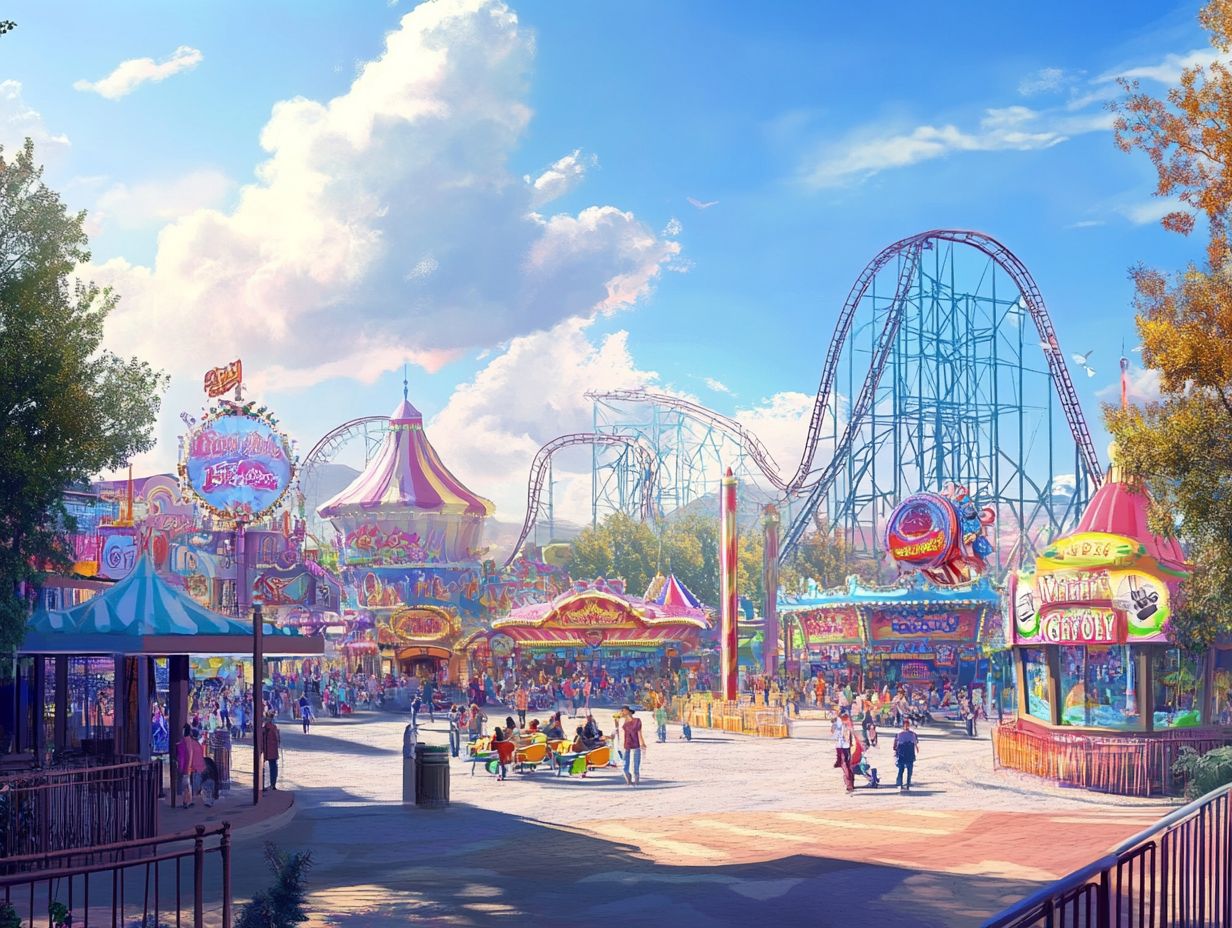Amusement parks are leveraging technology to enhance the guest experience, with location analytics and spatial analysis playing a vital role in this transformation. By utilizing data analysis, parks can provide personalized attraction recommendations, real-time updates, and efficient crowd management, ensuring that every visit is enjoyable. This article outlines the benefits of location analytics, ranging from improved park operations and revenue optimization to customized experiences for guests, and explains how implementing these insights can enhance your next trip to the park.
What is Location Analytics and How Does it Work?

Location analytics involves using real-time data and geolocation to analyze and interpret patterns, trends, and insights related to visitor movements, foot traffic, and behaviors in physical spaces, such as amusement parks.
By employing various data collection methods, this approach enables park operators to enhance customer insights and make data-driven decisions that improve guest experiences, operational efficiency, and visitor retention.
This advanced technique is made possible through the integrated use of sensor technology, mobile applications, and data visualization tools that track visitor flow and behavior in real time.
GPS-enabled devices and beacons help park management collect crucial spatial data on how visitors navigate between attractions, identify the most popular areas, and pinpoint where bottlenecks occur.
Mobile applications with customized features gather user preferences and demographic data, allowing operators to tailor experiences to meet customer needs. These insights can then be utilized to develop optimal park layouts, enhance signage, and improve amenities, ultimately creating a more enjoyable environment that aligns with visitor habits and increases engagement.
Benefits of Using Location Analytics in Amusement Parks
The benefits of utilizing location analytics in amusement parks include enhanced guest experiences, improved park operations, and strategic planning.
By leveraging real-time data and customer insights, operators can refine their visitor engagement strategies, enhance queue optimization, and optimize marketing efforts to better align with guest demographics and preferences.
Improved Guest Experience and Park Operations

Enhancing the guest experience and improving park operations are interconnected objectives that location analytics and predictive analytics can help achieve in amusement parks. By evaluating operational metrics alongside visitor satisfaction metrics, parks can gain a deeper understanding of the customer journey and identify areas for improvement, ultimately leading to enhanced guest experiences.
This comprehensive approach enables park management to make more informed decisions regarding attractions, amenities, and overall park design.
Utilizing various data collection methods such as surveys, comment cards, and mobile app suggestions can provide valuable insights into guest preferences, demographic analysis, and real-time issues. Analyzing flow patterns and wait times equips decision-makers with the necessary data to optimize ride placements and prevent bottlenecks in high-traffic areas.
Overall, the integration of operational metrics, guest feedback, and guest journey mapping fosters a park environment that aligns with guest needs and actively addresses them, thereby increasing guest loyalty and satisfaction.
How Location Analytics Can Enhance Guest Experiences
Location analytics has the potential to transform the guest experience in amusement parks by enabling personalized experiences tailored to individual preferences, behaviors, and behavioral patterns.
By analyzing visitor flow, user behavior, and engagement metrics, parks can implement targeted marketing strategies, optimize ride wait times, and provide customized recommendations that significantly enhance visitor engagement and satisfaction.
Personalized Recommendations and Navigation

Personalized recommendations and effective enhanced navigation are essential for enhancing the guest experience in amusement parks, made possible by advanced location analytics technologies.
Through a dedicated mobile app, parks can offer real-time navigation solutions that guide guests to their desired attractions and amenities while providing tailored recommendations based on individual preferences, demographic data, and past visitor interactions.
By utilizing interactive maps and mapping features, visitors can easily explore the park and discover hidden gems they might otherwise overlook. The app can also generate personalized itineraries to help guests use their time efficiently, aligning their visit with their interests—whether they prefer thrill rides, family-friendly activities, or dining options.
Encouraging user interaction through feedback collection is vital, as it not only helps parks adapt their offerings to meet evolving guest expectations but also fosters engagement, making visitors feel valued.
This ongoing dialogue ensures that the content remains not only relevant but also genuinely engaging for everyone.
Real-time Wait Time Updates and Crowd Management
Real-time wait time analytics and effective crowd management are essential for maintaining high visitor engagement in amusement parks, facilitated by location analytics.
By leveraging real-time data on ride wait times and visitor flow, parks can implement strategies that enhance operational efficiency, minimize bottlenecks, and increase overall guest satisfaction through effective queue optimization.
One effective solution is the introduction of virtual queuing systems that enable guests to reserve their place in line through a mobile app, allowing them the freedom to enjoy other attractions without the frustration of long waits.
Additionally, heat maps provide real-time feedback on crowd density throughout the park, enabling management to direct visitors to less congested areas or adjust staff allocation to improve guest services and resource allocation.
Implementing Location Analytics in Amusement Parks

The implementation of location analytics in amusement parks relies on a clear understanding of the challenges posed by technology integration and the solutions available to overcome them.
Key challenges include data collection methods, technology adoption, staff training, and ensuring accurate data analysis. However, the latest advancements in technology provide potential solutions to these implementation challenges in amusement parks.
Challenges and Solutions
The challenges associated with location analytics in amusement parks can be significant, including issues related to data privacy, user behavior tracking, and complexities in technology adoption. If parks can identify these challenges early and implement targeted solutions, they can successfully navigate the pitfalls of using operational metrics and enhance their overall capabilities.
One major challenge is the reluctance of staff and management to embrace new technology, as some may resist adopting tools they are unfamiliar with. To address this issue, proper training and workshops should be conducted to ensure that all team members feel comfortable and knowledgeable about the new systems.
Another challenge involves data security concerns, especially when handling sensitive customer information, which necessitates the implementation of robust security protocols. For instance, a large entertainment park successfully overcame these challenges by establishing customer consent processes and utilizing encryption methods to protect personal information.
Such proactive measures not only help ensure compliance but also build trust with patrons and maximize the potential benefits of location analytics, including experience enhancement and visitor loyalty.
Best Practices for Successful Implementation
Implementing location analytics in amusement parks effectively involves best practices that ensure successful technology adoption, maximizing operational insights while enhancing the guest experience through effective experience personalization.
Key methods include effective data collection, targeted staff training, and a strong focus on user engagement and feedback.
Prioritizing user engagement is crucial, as it encourages guests to provide feedback on their experiences through the analytics platform. Frequent collection of this feedback not only improves services but also fosters a sense of community by making guests feel valued and heard.
Additionally, providing robust support for staff enables employees to use the analytics tools efficiently, thereby maximizing operational efficiency and improving visitor satisfaction.
This comprehensive approach significantly contributes to high levels of customer satisfaction by delivering memorable experiences that encourage repeat visits, foster customer loyalty, and effectively utilize location intelligence.





